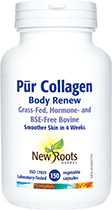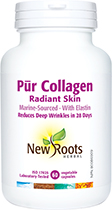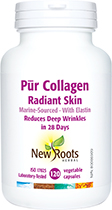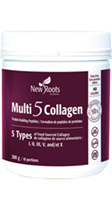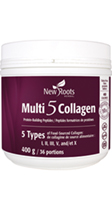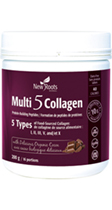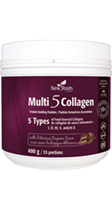Collagen: The Scaffolding Molecule
Collagen is the most abundant protein in the body. With over 28 different subtypes, collagen represents one of the most important tissues in the body. Think of it as the scaffolding for the human body. Due to its blend of rigidity and resistance to stretching, collagen is the perfect building block for skin, tendons, bones, ligaments, blood vessels, muscles, and an array of other tissues. Clearly, collagen is essential to the human form and function.[1], [2] But what is it, and where does it come from?
What is Collagen?
Collagen is a complex protein made of essential amino acids (protein building blocks) such as glycine, proline, hydroxyproline, and arginine. In addition to the amino acids that make up collagen, other nutrients like vitamin C and iron are required for the proper synthesis of collagen.[3]
Collagen can be endogenous, meaning our bodies manufacture it, or exogenous, meaning it is obtained through an external source (like food or supplements). For the sake of being succinct, we will review the most common types of collagens, namely types I, II, III, IV and V.
Where Can We Find Collagen in the Body?
Type I Collagen
Type I collagen is, by far, the most abundant protein in humans and accounts for upward of 90% of human collagen. It assembles into fibres that form the structural and mechanical scaffolding for bones, skin, tendons, cornea, and blood-vessel walls.[4], [5]
Type II Collagen
Type II collagen is the predominant collagen subtype found in joint cartilage.[6], [7]
Type III Collagen
Type III collagen is the second most abundant collagen, making up about 5–20% of all the collagen in the human body.[8], [9] The skin, lungs, kidneys, liver muscle, and blood vessels are the most common locations for type III collagen.[10] It is also found as a major structural component in hollow organs such as large blood vessels, uterus, and bowels, where it provides tensile strength to these organs, allowing them to stretch without rupturing.
Type IV Collagen
Type IV is the main collagen component of the basement membrane—the basal layer of blood-vessel walls, skin, and organs. It is a network-forming collagen that functions as a barrier between tissue compartments. It is found mostly in the skin, blood vessels, and joint space.[11], [12]
Type V Collagen
Collagen type V is one of the principal components of cell surfaces and placenta.[13]
What Are the Health Benefits of Collagen?
Reducing Joint Pain
Type-I collagen might be beneficial for osteoarthritis, by reducing inflammation and increasing cartilage production.[14]
Given it contains a lot of glucosamine and chondroitin—two anti-inflammatory sulfur-based compounds—type II collagen helps reduce joint pain and inflammation and finds its use in improving symptoms of arthritis.[15] Additionally, type II collagen appears to reduce immunologic attack and destruction of joint cartilage in studies of its effects in knee osteoarthritis.[16]
 Skin Health
Skin Health
A double-blind study on 69 women between the ages of 35 and 55 analyzed if collagen could help decrease signs of aging. The participants of the study were given either 2.5 g or 5 g of collagen hydrolysate or a placebo over the course of eight weeks. The results of the study showed skin elasticity of the collagen groups were statistically improved compared to those participants who were taking a placebo.[17]
Aiding in Healing
Other functions of type III collagen include interaction with platelets during the process of blood clotting, and it is also an important signalling molecule in would healing.[18]
Improving Digestion
A study was conducted on 170 patients who were dealing with inflammatory bowel disease, and researchers found that these individuals had lower levels of serum collagen. Those with low levels of collagen were more prone to gut inflammation.[19] In animal models, supplementation with fish collagen reduced markers of inflammation and oxidative stress in the colon.[20]
How Can I Increase My Collagen Intake?
It is clear to see, now, how important collagen is for us humans. Whether it’s type I, II, III, IV, or the other 23 subtypes, the presence of collagen is pivotal for the structure and function of the human body.
Collagen production—at least collagen types I and III—appears to decrease with age.[21] As such, increasing your collagen intake through foods and/or supplementation under the advisement of your primary health-care practitioner should be considered. You may also want to talk to your doctor about supporting your body’s own production of collagen by increasing your intake of the cofactors needed for endogenous collagen production discussed above.
The main cofactor is vitamin C,[22] but manganese,[23] copper,[24] and zinc [25] are also needed for collagen production.
To up your collagen intake, you can include:
- Collagen-rich meat sources such as chicken, beef, turkey, pork, and fish
- Bone broth
- Collagen powder
Dr. Colleen Hartwick, ND
Dr. Colleen Hartwick is a licensed naturopathic physician practising on North Vancouver Island, BC, with a special interest in trauma as it plays a role in disease.
campbellrivernaturopathic.com
References
[1] Wu, M., K. Cronin, and J.S. Crane. “Biochemistry, collagen synthesis.” In: StatPearls [Internet]. Treasure Island: StatPearls Publishing, 2022. https://www.ncbi.nlm.nih.gov/books/NBK507709/ · Updated 2022‑09‑12.
[2] Ricard‑Blum, S. “The collagen family.” Cold Spring Harbor Perspectives in Biology, Vol. 3, No. 1 (2011): a004978
[3] Albaugh, V., K. Mukherjee, and A. Barbul. “Proline precursors and collagen synthesis: Biochemical challenges of nutrient supplementation and wound healing.” The Journal of Nutrition, Vol. 147, No. 11 (2017): 2011–2017
[4] Léon‑Lopez, A., A. Morales‑Peñaloza, V.M. Martínez‑Juárez, A. Vargas‑Torres, D.I. Zeugolis, and G. Aguirre-Álvarez. “Hydrolyzed collagen—Sources and applications.” Molecules, Vol. 24, No. 22 (2019): 4031.
[5] Makareeva, E., and S. Leikin. “Collagen structure, folding and function.” Chapter 7 (p. 71–84) in: Shapiro, J.R., P.H. Byers, F.H. Glorieux, and P.D. Sponseller, eds. Osteogenesis imperfecta: A translational approach to brittle bone disease. London: Academic Press, 2014, 555 p., ISBN 978‑0‑12‑397165‑4.
[6] Leon-Lopez et al. “Hydrolyzed collagen.”
[7] Pfiffner, M. “Type‑II collagen.” Examine.com. https://examine.com/supplements/type-ii-collagen/ · Updated 2022‑09‑28.
[8] Nielsen, M.J., and N.A. Karsdal. Biochemistry of collagens, laminins and elastin: Structure, function, and biomarkers. London: Academic Press, 2016, 238 p., ISBN 978‑0‑12‑809847‑9.
[9] Kuivaneimi, H., and G. Tromp. “Type III collagen (COL3A1): Gene and protein structure, tissue distribution, and associated diseases.” Gene, Vol. 707 (2019): 151–171.
[10] Albaugh, Mukherjee, and Barbul. “Proline precursors and collagen synthesis.”
[11] Leon-Lopez et al. “Hydrolyzed collagen.”
[12] Kuivaneimi and Tromp. “Type III collagen (COL3A1).”
[13] Leon-Lopez et al. “Hydrolyzed collagen.”
[14] Dar, Q.‑A., E.M. Schott, S.E. Catheline, R.D. Maynard, Z. Liu, F. Kamal, C.W. Farnsworth, et al. “Daily oral consumption of hydrolyzed type 1 collagen is chondroprotective and anti-inflammatory in murine posttraumatic osteoarthritis.” PLoS One, Vol. 12, No. 4 (2017): e0174705
[15] Pfiffner. “Type-II collagen.”
[16] Bakilan, F., O. Armagan, M. Ozgen, F. Tascioglu, O. Bolluk, and O. Alatas. “Effects of native type II collagen treatment on knee osteoarthritis: A randomized controlled trial.” The Eurasian Journal of Medicine, Vol. 48, No. 2 (2016): 95–101.
[17] Proksch, E., M. Schunck, V. Zague, D. Segger, J. Degwert, and S. Oesser. “Oral intake of specific bioactive collagen peptides reduces skin wrinkles and increases dermal matrix synthesis.” Skin Pharmacology and Physiology, Vol. 27, No. 3 (2014): 113–119.
[18] Kuivaneimi and Tromp. “Type III collagen (COL3A1).”
[19] Koutroubakis, I.E., E. Petinaki, P. Dimoulios, E. Vardas, M. Roussomoustakaki, A.N. Maniatis, and E.A. Kouroumalis. “Serum laminin and collagen IV in inflammatory bowel disease.” Journal of Clinical Pathology, Vol. 56, No. 11 (2003): 817–820.
[20] Rahabi, M., M. Salon, C. Bruno‑Bonnet, M. Prat, G. Jacquemin, K. Benmoussa, M. Alaeddine, et al. “Bioactive fish collagen peptides weaken intestinal inflammation by orienting colonic macrophages phenotype through mannose receptor activation.” European Journal of Nutrition, Vol. 61, No. 4 (2022): 2051–2066.
[21] Varani, J., M.K. Dame, L. Rittie, S.E.G. Fligiel, S. Kang, G.J. Fisher, and J.J. Voorhees. “Decreased collagen production in chronologically aged skin.” The American Journal of Pathology, Vol. 168, No. 6 (2006): 1861–1868.
[22] Boyera, N., I. Galey, and B.A. Bernard. “Effect of vitamin C and its derivatives on collagen synthesis and cross‐linking by normal human fibroblasts.” International Journal of Cosmetic Science, Vol. 20, No. 3 (1998): 151–158.
[23] Muszyńska, A., J. Pałka, and E. Gorodkiewicz. “The mechanism of daunorubicin-induced inhibition of prolidase activity in human skin fibroblasts and its implication to impaired collagen biosynthesis.” Experimental and Toxicologic Pathology, Vol. 52, No. 2 (2000): 149–155.
[24] Harris, E.D., J.K. Rayton, J.E. Balthrop, R.A. DiSilvestro, M. Garcia‑de‑Quevedo. “Copper and the synthesis of elastin and collagen.” Ciba Foundation Symposium, Vol. 79 (1980): 163–182.
[25] Fernandez‑Madrid, F., A.S. Prasad, and D. Oberleas. “Effect of zinc deficiency on nucleic acids, collagen, and noncollagenous protein of the connective tissue.” The Journal of Laboratory and Clinical Medicine, Vol. 82, No. 6 (1973): 951–961.

 Stores
Stores

